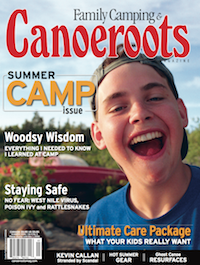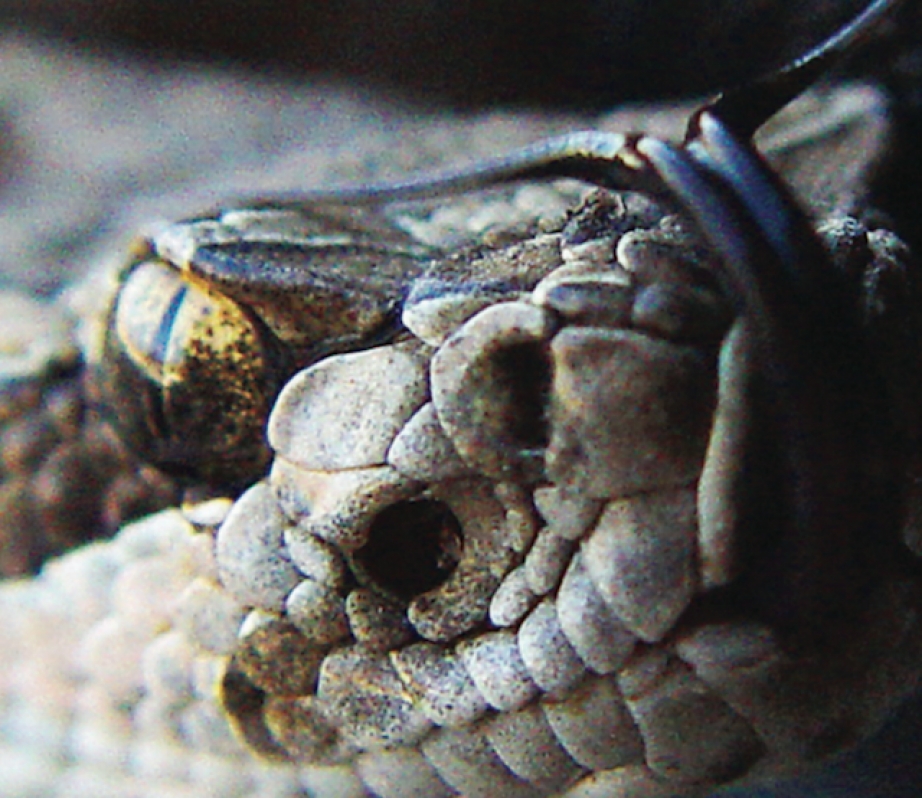In the 1960s, when hippies were singing about free love and protesting the seal hunt, Ontario’s provincial park officials were clubbing massasauga rattlesnakes to death. But today, Kenton Otterbein, the head naturalist at Killbear Provincial Park, says campers are learning to live peacefully with Ontario’s only venomous snake, a species he describes as “darn cute.”
Most people wouldn’t think of massasauga rattlesnakes as cute. But then, most people don’t know much about them. They are less than three feet long with a dark and light blotchy pattern. Baby rattlesnakes are born alive without a rattle. At about 10 days of age they will rub against a rock and pull out of their first skin. The skin will catch on a knob at the end of their tail and the first segment of the rattle will form. They will add another segment two or three times each year when they shed their skin.
When camping and travelling in Ontario’s rattlesnake country it is rare to ever hear the rattle of a massasauga. They want nothing more than to avoid contact with humans. Being cold-blooded, they are only active within a narrow temperature band, one only reached between the hours of noon and 4 p.m. during the spring and between 4 and 10 p.m. during the summer.
Nonetheless, persecution by humans has relegated massasauga rattlesnakes to only a few pockets of habitat in Ontario, the most notable being the eastern shore of Georgian Bay. Statistics kept by the staff at Killbear Provincial Park indicate that, though incidents are rare, the people most often bitten by a massasauga rattlesnake are 18- to 30-year-old men, who’ve been boozing and are acting like the Crocodile Hunter—the guy from the television show of the same name who travels around the world catching poisonous reptiles and insects to impress his female co-stars. The other recorded snake bites are the results of people accidentally stepping on a snake in the dark. Otterbein at Killbear says the chances of being bitten are very low,
“There is a greater risk of drowning in a bathtub at home than being bitten by one of our rattlesnakes.”
In those rare cases that a snakebite does occur, first aid is the same as it is for any small puncture wounds says Lorraine Vankoughnett, the acting director of acute care at West Parry Sound Hospital. Parry Sound hospitals treat up to six bites per year and provide medical research and education across Canada. Vankoughnett says the best thing to do is to stay calm, clean the wound, bandage it loosely and seek medical help. “And do not bring me the snake,” she adds, in the hopes of dispelling a myth.
At the hospital, Vankoughnett and her team would perform blood tests and observe the patient for up to 24 hours. They have found that in one out of every four snakebites there is no venom injected into the wound. From the snake’s perspective, biting a human is defensive and a waste of its precious venom. They need to save their venom for mice.
Researchers for the Metro Toronto Zoo estimate the massasauga rat- tler population in Ojibway Park near Windsor to be fewer than 200 snakes in an area less than one square kilo- metre. Paul Pratt, a naturalist for the City of Windsor, says the snakes are a good indicator of the health of the environment: “A top-of-the-line predator like the massasauga rattler makes the ecosystem intact. If there are only a few types of plants and mice, the area is not complete.”
For a long time, people living in massasauga rattlesnake country believed that the only good snake was a dead snake. Although most wanton killings have stopped, humans are still the only real threat to the massasauga rattlesnake, and Pratt points out that we are much more of a hazard to their survival than they are to ours.
With educational programs like Killbear’s Brake for Snakes motorist-awareness campaign, The Metro Toronto Zoo’s Save our Snakes educational effort and the Ojibway Nature Centre’s live snake display, people are slowly warming up to this cold-blooded cutie, allowing the shy massasauga rattlesnake to get on with hunting its prey of mice, not men.
Venom Vitals
- Seven people were bitten by massasauga rattlers in Ontario last year.
- The massasauga rattler’s fangs are 5–6 mm long.
- A lethal dose of massasauga venom for humans is 30–40 mg.
- One bite injects up to 6 mg of venom (do the math… you’d have to be bitten five or six times to be in danger).
- Mice die as quickly as three minutes after a bite.
- Massasauga rattlesnake venom is not a true poison, it is a hemolytic that prevents blood from clotting.
- Most human rattlesnake bites are associated with the consumption of alcohol (by the human, not the snake).
- No one in Ontario has died of a snake bite in the last 45 years.

This article first appeared in the Summer 2006 issue of Canoeroots Magazine.




